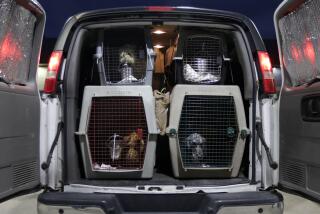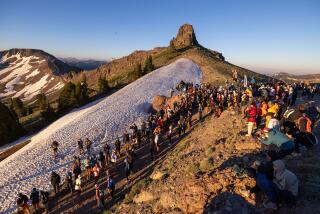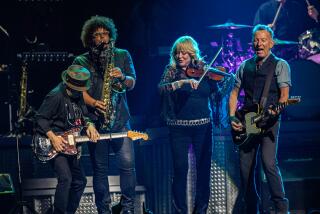On Their Marks, Get Set, Snow!
MAMMOTH LAKES — Tail tucked between her legs, FloJo the sled dog is shaking. She peeks at the trail in Inyo National Forest. The snow--12 inches deep, packed tight, on rolling hills--begs for a fast break. The seven other members of the team unleash a soulful howl: “Arr-arr-arr-arrrrrr!” Under a late-afternoon sun, after a six-hour drive from Silver Strand Beach near Oxnard, they strain at tethers holding them to the bed of a four-wheel-drive truck.
Their cries merge into a strangled yelp of longing for the unfamiliar thicket of Jeffrey pines ahead: “Owooooo-Owooooo ... “ The dogs’ usual training ground is closer to home in Ventura and Los Angeles counties, where they practice on dirt. Here, at an elevation of 8,000 feet, in 30-degree weather, seven-eighths of the Seawolf sprint team is impatient for its first snow workout of the season.
From January to March, more than a dozen sprint competitions take place on the sled dog racing circuit throughout the West. In tiny Northern California towns, where schoolchildren wave hand-drawn signs saying “Go Mushers!,” the Seawolves will compete in the speedy eight-dog, eight-mile division. (The winning team typically runs under a 4-minute mile.)
For sprint dogs, the key is speed rather than the extreme endurance required of teams in storied long-distance races such as the 1,150-mile Iditarod. (The Arctic Challenge, the fictional competition featured in Disney’s “Snow Dogs,” is the Hollywood version of that event.) Preston Springston, 53, knows his Seawolves aren’t the fastest around, but that’s OK. The ex-surfer turned musher says the fun is in hanging out with his dogs in the mountains and desert, and figuring out how to turn eight independent huskies into one joyful force.
He is a married father of two, a civil engineer who chuckles at the foibles of his dogs as if they were his newborns. In 1994, the year he started out racing, Springston began training four huskies, including a slacker dog named Blaze, to pull a homemade wooden cart by the sea. Once, in the middle of a run, Blaze laid down on the trail and put his paws in the air to signal that he was calling it a day.
This season, Springston sees the way his team is hunkering down on the trail in classic sled dog form: heads down, tails down, shoulders hunched. On their weekend in Mammoth, the noisy Alaskan and Siberian huskies leap with anticipation while Springston slips a harness around each one. FloJo, the team’s newest member, ducks under the Toyota truck. She is a skinny Alaskan husky-hound mix, which means that, unlike the other dogs, she has ears that flop down. This is her first trip away from home.
Springston grabs FloJo and hooks her harness into the gang line--a stretchy cord that connects the dogs, two by two, to the rest of the team. In a snowsuit, snow boots and billed fleece cap, Springston positions himself on the sled’s rear runners. He grins at the sight of all eight lunging, barking dogs. “FloJo’s all into it now,” he notes.
Springston reaches down and pops the snow hook, an anchor that secures the dogs to the ground. “Readyyyyyyy, go!” he shouts. The dogs shoot off straight and true. They fly over a mogul and disappear around a shady bend.
The team is silent now. Heads down, tails down, shoulders hunched.
California Mushers Use Open Spaces, Trails
Throughout California, mushers practice on any long, wide stretch of land such as a vineyard, an orchard or railroad tracks, places with a minimum of loose dogs or other distractions, says Charlene LaBelle, treasurer of the Sierra Nevada Dog Drivers Assn. The group has about 100 members in California and Nevada, in cities like San Jose and towns such as Los Gatos in the Silicon Valley. A few mushers live in Southern California, mostly in the high desert. In the winter, sprint drivers head to snowfields for speed workouts and practice in handling turns in powder and ice; mushers like Springston are stuck on dirt trails in the desert until they can make it to a place like Mammoth on a weekend.
“People are blown away that these [mushers] in California run dogs,” LaBelle says. “We really blow them away when we win.” In fact, California has produced a couple of world-class mushers such as international gold medalist Ralph Whitten of Truckee, a sprint team driver.
Mushers in the state gravitate toward sprints, which require as few as two dogs and wrap up in a weekend. By contrast, on March 2, Iditarod teams of 12 to 16 dogs will begin trekking across the Alaskan wilderness for up to 17 days in long hours of darkness.
The Iditarod champion takes home $68,571 of a $600,000 purse. In California’s races, prize money typically totals $3,000, which is divided among the top finishers in six categories. If you have a good year, your winnings might put a dent in the dog food bills.
Last season, the Seawolves--the state’s No. 1 team in its division-- won a total of $600, which almost covered Springston’s gas expenses. Actually, Springston acknowledges, his team is on top because of a quirk in the ratings system determined by the International Sled Dog Racing Assn., which tracks 2,234 mushers worldwide.
Springston likes to compete close to home, so the Seawolves run more races in California-- than other top teams that actually beat them to the finish line by, oh, 20 minutes or so. But even coming in a late second or third moves them up in the overall rankings. The point isn’t for Springston’s team to lead the pack. “This whole thing is a big adventure,” he says.
Training runs are ripe for the unexpected. Sometimes, Springston will fall off the sled, holding on with one arm, and slide on his knees for several yards in snow. Sometimes, he’ll be upright on the sled, at 6 foot 3, 215 pounds--about 50 pounds heavier than the average sprint musher--and the dogs will send him airborne on a downhill stretch.
Siberian Husky With a Behavior Problem
Springston grew up in Virginia Beach, Va., with dogs, and so did his kids in Silver Strand Beach. In 1992, after the family’s obedient little spaniel-shepherd died of old age, Springston headed to the pound. He picked out a quiet Siberian husky, Czar, who had a behavior problem. Czar spent three years in obedience school, where Springston learned how to work with dogs. And he learned what made Czar tick.
If Czar got loose, he would run forever. So on weekends, Springston began taking Czar to Mt. Pinos near Frazier Park and let the dog pull him on cross-country skis.
In 1994, Springston acquired two more huskies. One day, on the beach, he met someone who was walking a Siberian husky named Sheeba and asked to borrow her. He began training the four dogs at Oxnard Shores, while keeping his eyes open for other huskies. Eventually, he cobbled together a team that he ran for five years. But the loaner dogs sometimes moved away.
Springston began acquiring more huskies of his own and had to start housing them in a nearby training kennel. Two of the dogs, Katya and Bandit, live in his backyard, where they romp and wrestle and hunt rabbits.
Now he owns all of the Seawolves except timid FloJo, whom he borrows from another musher. FloJo, 8, is built for speed, slim and muscular, with long, lean legs. She has run with other teams, sometimes as the lead dog. But when she joined the Seawolves in the fall, Springston couldn’t get her to walk from her owner’s trailers to his, 20 feet away. Springston didn’t mind the three or four visits he made before FloJo finally stopped slinking to the ground. These days, she is turning into “a little professional” for the Seawolves.
“I like working with the dogs,” Springston says. “It’s real cool when they’re all trained, and all those little sets of ears are all perked, and they’re all listening to you. A good, clean run, everyone working--it’s a real good feeling.”
In practices this season, Springston is running the rambunctious Harley as lead dog. Harley is a big, strong 4-year-old with one blue eye and one brown. (Harley and his energetic partner, Niki, make up half of the team’s strength, but power isn’t everything. ... Last year, as a rookie, Harley learned only the command “Let’s Go!” and ignored nine or so others such as “Gee” for turn right or “Haw,” for turn left.
But Harley is showing potential. He finally broke the habit of spinning in circles and tangling his harness. Harley hates to see other teams ahead of him. If he gets a lock on one, Springston says, “he’s going to dig and pull and bust his butt until he catches up.”
“It’s really easy to chase the furry butt that’s in front of you,” Springston says. “But to be up in front, with everyone else behind you? It takes a lot of confidence to keep going in a straight path down the trail. It takes a lot of concentration and dedication. Not too many dogs can do it.”
In the last few years, his lead dogs have done him proud. Two seasons ago, at a race in Markleeville, now-retired lead dog Jackie steered the team through a blizzard and 30 mph winds across an open meadow. Eight inches of powder blitzed across the trail, which Springston could no longer see. An impatient lead dog would have tried to cut across the meadow, off trail, and paralyze the team in 4 feet of snow. Nose to the ground, Jackie never veered off the path.
What he loves about his dogs, Springston says, is that they have the heart to run.
The Dogs Train by Pulling Tires
Training starts with summer runs on a 1.5-acre field at the dogs’ kennel in Somis, north of Camarillo. Springston works with the dogs individually, running them on a mountain bike or coaching them to pull tires. In late October, the team begins training in the local mountains and in the high desert, at elevations ranging from 3,000 to 5,000 feet. (Springston and the dogs must get used to race conditions, which means cold, snow and altitude; in warm, humid air, the dogs can overheat in their thick coats.)
On dirt trails, Springston says, the goal is to work on the dogs’ strength and conditioning--the Seawolves pull him on a 125-pound wheeled cart--and then wait for the first major snowfall in Mammoth. In deep snow, the focus switches to speed training with a 25-pound sled. The workouts are for Springston, too, who practices shifting his weight on turns in the snow and jumps off the sled to help the dogs on tough uphill climbs.
On this afternoon, the dogs trot back to the parking lot after their six-mile run near Mammoth’s Lookout Mountain. Bits of ice stick to their fur, and their breath clouds the air. (After tough races, icicles of drool drip from their muzzles.) Springston and his 25-year-old son, Adam Springston, tether the dogs back to the truck.
Springston kneels, with a kind word and caress for each one. He checks their paws while Adam hands out uncooked wieners as appetizers before a dinner of hot kibble mixed with fatty hamburger and rice. Sitkin, a Siberian husky, has a tiny cut on a front paw from a shard of ice or rock but isn’t in pain. Otherwise, Springston is happy with the run. The dogs don’t nip at one another as they used to, and none of them stops very often to sniff a pine. A single straying dog would mean a huge tangled mess because the sled doesn’t stop immediately. “The thing I really like about the team,” Springston says, “is that each dog has got a good work ethic. When they’re in the harness, nobody’s fooling around.”
The next morning, in a 40-degree heat wave, Springston slips black nylon booties on Sitkin’s front paws. Harness time. Again, the dogs go crazy. Again, FloJo’s tail droops.
More frantic cries, and within a few minutes, the dogs are in position; Harley and Niki, his usual partner, are at the lead. Again, the dogs fall silent at takeoff, and the sled rumbles over the snow--this time, with an unexpected load of 100 pounds and change. An extra passenger is on board, in the sled’s basket. Harley reacts immediately; his part of the gang line goes slack. “Harley, let’s go!” Springston says and repeats himself twice. Harley glances back then forges ahead. “G’dog, Harley! Hurry up, [Sitkin]! Let’s go, Mish! That’s a boy.”
Springston’s directions are firm but not sharp. The dogs pick up speed. The wind whizzes by; pebbles of ice pelt the dogs. The sled skids, flies and bumps. Five minutes later, Springston calls “Whoa!” and the dogs stop to let the extra passenger off. Then they rush off to finish the nine-mile loop--three miles longer than their usual workout--on a trail that includes a steep run up and down the backside of the mountain.
Thirty minutes later, the Seawolves return. You hear them first, panting through the trees. Then you see them, their tongues hanging low, still holding strong. There’s Sitkin, with only one bootie; he will lose the other bootie by the end of the run. There’s Niki, in front, 70 pounds and movie-star handsome. And loping next to Niki, looking like a little kid, is a new lead dog: 48-pound FloJo.
As it turns out, Harley never recovered from the shock of the temporary passenger. He was distracted, looking around on the trail. So Springston decided to try FloJo as lead. Harley settled down in FloJo’s old spot, two rows back. And FloJo? “She did a great job,” Springston says. For instance, “a squirrel passed the trail and went on high. If Harley was in lead, we would be up that hill. FloJo took us right on by.”
“In the movies,” he says, “they make you believe the lead dog is the dominant dog. That’s not necessarily the truth. ... It’s more who doesn’t worry about the other dogs behind them.”
The team probably will fit in one more snow camping trip before its first race on Feb. 9 in Chester (population: 2,300), east of Redding. Springston won’t pencil in the dogs’ positions until he can assess the trail’s condition and the other teams on race day. For now, though, the dog he sees up front is the newcomer, steady-as-she-goes FloJo.
More to Read
Sign up for The Wild
We’ll help you find the best places to hike, bike and run, as well as the perfect silent spots for meditation and yoga.
You may occasionally receive promotional content from the Los Angeles Times.






